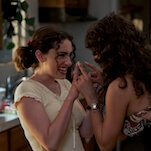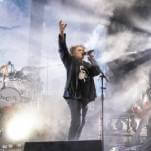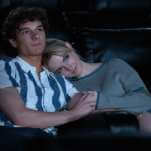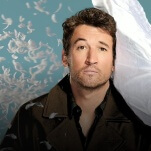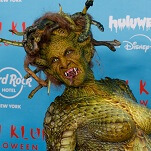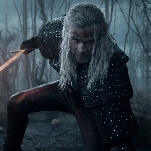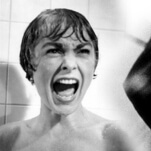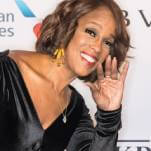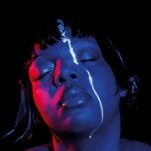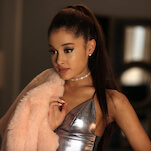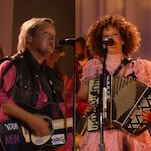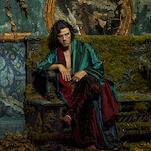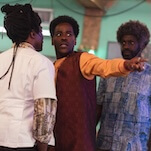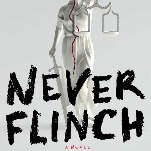Several years after Twilight faded and the post-apocalypse replaced the supernatural in the zeitgeist, Syfy takes a chance with Bitten, a Canadian import based on the Women Of The Otherworld series by Kelley Armstrong. The show centers on Elena Michaels (Smallville’s Laura Vandervoort), the only known female werewolf. She is desperately trying to live a normal life in Toronto, save for the occasional “run” where she undresses and wolfs out (in acceptable made-for-TV CGI), telling her hunky boyfriend she’s on a late-night photo shoot. But Elena rejects her werewolf self. She’s on the run from her old life where she was a member of the New York-based Danvers pack, but a tragedy calls her back to the stately Stonehaven estate, her former home, filled with equally comely werewolf brethren. The problem is that a woman has been maimed on Stonehaven’s grounds and local authorities suspect animal attack. Turns out they’re half right.
Werewolves, in the world of Bitten, are split into two factions. There’s the pack variety, who live by a set of strict rules to protect their identity. Anyone who threatens their secret will soon sincerely miss their jugular. They’re not candidates for murder, since they try to keep their more dogged side on the down low. The other faction, a group of mutts, is a lawless bunch at odds with the Danvers pack. Elena is brought back because she’s the best tracker of the bunch and essential to finding the murderer in their midst, who is not so keen on the Danvers kind. The presentation of mythology and backstory, such an important aspect of a show like Bitten, is handled in a laughably inelegant way. In the second episode, Elena retreats to a basement haven where the were-mutt dichotomy is presented through a voiceover that’s so intent on sounding old-timey and important that it comes off as anything but.
It’s one of the more disappointing aspects of the series, but it does contain an interesting idea about gender politics and supernatural popular culture. In a lot of ways, Elena is similar to many of the supernatural soap heroines before her: Bella Swan, Sookie Stackhouse, or the subgenre’s other Elena, the one at the center of The Vampire Diaries. She’s gorgeous, yet doesn’t believe it or buy into it. She keeps her true self initially isolated, yet she’s inherently special. This is an important audience-identification point: She’s a normal woman who is pushed into extraordinary circumstances that almost always involve hot dudes (and you can be too, dear reader/viewer). Like these other women, Vandervoort’s character is torn between the attraction of two men that range on the good guy-bad guy spectrum. Elena has her comforting, safe human boyfriend who knows nothing of her hairy secret as well as the brooding, dangerous Clay Danvers (Greyston Holt), her first love who precipitated her departure from the pack in the first place.
Elena is different because she’s a werewolf, a creature normally associated with men. While there were women werewolves in True Blood, it’s Alcide who gets most of the attention. The same could be said for Tyler and The Vampire Diaries. There’s a primalness to werewolves that’s associated with masculine qualities, as are the aspects of social hierarchy and the idea of an alpha. Vampirism also has its roots in the male, but even Dracula had a bevy of women that were just as dangerous as he was. Bitten acknowledges the otherness of Elena’s gender through that aforementioned ridiculous voiceover. She’s the only female werewolf because werewoman are made, not born, and women aren’t thought to be strong enough to handle the werewolf bite necessary for transformation.
Yet, Elena was strong enough. But the sexual politics are muddled in Bitten, at least in the episodes sent to critics. The idea that women as a whole can’t handle the werewolf transformation is supposed to make Elena singular, but women’s inherent weakness doesn’t bode well for the representation of the rest of the gender. Similarly, two women are killed in direct reference to their sexual promiscuity and aggression. The death of the slut is a tried-and-true horror trope, but it’s at odds with Elena’s initial introduction: Through the sounds of her dominant lovemaking with her norm-boyfriend. It will be interesting to see how Bitten deals with the implications of bucking the gender trends of werewolf mythology, but it will be key to relay that mythology in a way that informs viewers, rather than make them giggle.
Created by: Daegan Fryklind and Grant Rosenberg
Starring: Laura Vandervoort, Greg Bryk, Greyston Holt, and Paul Greene
Airs: Mondays at 10 p.m. Eastern on Syfy
Format: Hour-long supernatural drama
Two episodes watched for review

